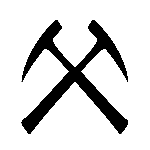60.2: History of geologic maps
- Page ID
- 22859
\( \newcommand{\vecs}[1]{\overset { \scriptstyle \rightharpoonup} {\mathbf{#1}} } \)
\( \newcommand{\vecd}[1]{\overset{-\!-\!\rightharpoonup}{\vphantom{a}\smash {#1}}} \)
\( \newcommand{\id}{\mathrm{id}}\) \( \newcommand{\Span}{\mathrm{span}}\)
( \newcommand{\kernel}{\mathrm{null}\,}\) \( \newcommand{\range}{\mathrm{range}\,}\)
\( \newcommand{\RealPart}{\mathrm{Re}}\) \( \newcommand{\ImaginaryPart}{\mathrm{Im}}\)
\( \newcommand{\Argument}{\mathrm{Arg}}\) \( \newcommand{\norm}[1]{\| #1 \|}\)
\( \newcommand{\inner}[2]{\langle #1, #2 \rangle}\)
\( \newcommand{\Span}{\mathrm{span}}\)
\( \newcommand{\id}{\mathrm{id}}\)
\( \newcommand{\Span}{\mathrm{span}}\)
\( \newcommand{\kernel}{\mathrm{null}\,}\)
\( \newcommand{\range}{\mathrm{range}\,}\)
\( \newcommand{\RealPart}{\mathrm{Re}}\)
\( \newcommand{\ImaginaryPart}{\mathrm{Im}}\)
\( \newcommand{\Argument}{\mathrm{Arg}}\)
\( \newcommand{\norm}[1]{\| #1 \|}\)
\( \newcommand{\inner}[2]{\langle #1, #2 \rangle}\)
\( \newcommand{\Span}{\mathrm{span}}\) \( \newcommand{\AA}{\unicode[.8,0]{x212B}}\)
\( \newcommand{\vectorA}[1]{\vec{#1}} % arrow\)
\( \newcommand{\vectorAt}[1]{\vec{\text{#1}}} % arrow\)
\( \newcommand{\vectorB}[1]{\overset { \scriptstyle \rightharpoonup} {\mathbf{#1}} } \)
\( \newcommand{\vectorC}[1]{\textbf{#1}} \)
\( \newcommand{\vectorD}[1]{\overrightarrow{#1}} \)
\( \newcommand{\vectorDt}[1]{\overrightarrow{\text{#1}}} \)
\( \newcommand{\vectE}[1]{\overset{-\!-\!\rightharpoonup}{\vphantom{a}\smash{\mathbf {#1}}}} \)
\( \newcommand{\vecs}[1]{\overset { \scriptstyle \rightharpoonup} {\mathbf{#1}} } \)
\( \newcommand{\vecd}[1]{\overset{-\!-\!\rightharpoonup}{\vphantom{a}\smash {#1}}} \)
\(\newcommand{\avec}{\mathbf a}\) \(\newcommand{\bvec}{\mathbf b}\) \(\newcommand{\cvec}{\mathbf c}\) \(\newcommand{\dvec}{\mathbf d}\) \(\newcommand{\dtil}{\widetilde{\mathbf d}}\) \(\newcommand{\evec}{\mathbf e}\) \(\newcommand{\fvec}{\mathbf f}\) \(\newcommand{\nvec}{\mathbf n}\) \(\newcommand{\pvec}{\mathbf p}\) \(\newcommand{\qvec}{\mathbf q}\) \(\newcommand{\svec}{\mathbf s}\) \(\newcommand{\tvec}{\mathbf t}\) \(\newcommand{\uvec}{\mathbf u}\) \(\newcommand{\vvec}{\mathbf v}\) \(\newcommand{\wvec}{\mathbf w}\) \(\newcommand{\xvec}{\mathbf x}\) \(\newcommand{\yvec}{\mathbf y}\) \(\newcommand{\zvec}{\mathbf z}\) \(\newcommand{\rvec}{\mathbf r}\) \(\newcommand{\mvec}{\mathbf m}\) \(\newcommand{\zerovec}{\mathbf 0}\) \(\newcommand{\onevec}{\mathbf 1}\) \(\newcommand{\real}{\mathbb R}\) \(\newcommand{\twovec}[2]{\left[\begin{array}{r}#1 \\ #2 \end{array}\right]}\) \(\newcommand{\ctwovec}[2]{\left[\begin{array}{c}#1 \\ #2 \end{array}\right]}\) \(\newcommand{\threevec}[3]{\left[\begin{array}{r}#1 \\ #2 \\ #3 \end{array}\right]}\) \(\newcommand{\cthreevec}[3]{\left[\begin{array}{c}#1 \\ #2 \\ #3 \end{array}\right]}\) \(\newcommand{\fourvec}[4]{\left[\begin{array}{r}#1 \\ #2 \\ #3 \\ #4 \end{array}\right]}\) \(\newcommand{\cfourvec}[4]{\left[\begin{array}{c}#1 \\ #2 \\ #3 \\ #4 \end{array}\right]}\) \(\newcommand{\fivevec}[5]{\left[\begin{array}{r}#1 \\ #2 \\ #3 \\ #4 \\ #5 \\ \end{array}\right]}\) \(\newcommand{\cfivevec}[5]{\left[\begin{array}{c}#1 \\ #2 \\ #3 \\ #4 \\ #5 \\ \end{array}\right]}\) \(\newcommand{\mattwo}[4]{\left[\begin{array}{rr}#1 \amp #2 \\ #3 \amp #4 \\ \end{array}\right]}\) \(\newcommand{\laspan}[1]{\text{Span}\{#1\}}\) \(\newcommand{\bcal}{\cal B}\) \(\newcommand{\ccal}{\cal C}\) \(\newcommand{\scal}{\cal S}\) \(\newcommand{\wcal}{\cal W}\) \(\newcommand{\ecal}{\cal E}\) \(\newcommand{\coords}[2]{\left\{#1\right\}_{#2}}\) \(\newcommand{\gray}[1]{\color{gray}{#1}}\) \(\newcommand{\lgray}[1]{\color{lightgray}{#1}}\) \(\newcommand{\rank}{\operatorname{rank}}\) \(\newcommand{\row}{\text{Row}}\) \(\newcommand{\col}{\text{Col}}\) \(\renewcommand{\row}{\text{Row}}\) \(\newcommand{\nul}{\text{Nul}}\) \(\newcommand{\var}{\text{Var}}\) \(\newcommand{\corr}{\text{corr}}\) \(\newcommand{\len}[1]{\left|#1\right|}\) \(\newcommand{\bbar}{\overline{\bvec}}\) \(\newcommand{\bhat}{\widehat{\bvec}}\) \(\newcommand{\bperp}{\bvec^\perp}\) \(\newcommand{\xhat}{\widehat{\xvec}}\) \(\newcommand{\vhat}{\widehat{\vvec}}\) \(\newcommand{\uhat}{\widehat{\uvec}}\) \(\newcommand{\what}{\widehat{\wvec}}\) \(\newcommand{\Sighat}{\widehat{\Sigma}}\) \(\newcommand{\lt}{<}\) \(\newcommand{\gt}{>}\) \(\newcommand{\amp}{&}\) \(\definecolor{fillinmathshade}{gray}{0.9}\)The oldest known use of mapping to depict the distribution of rock types on Earth’s surface was the Turin Papyrus Map, made in 1150 BCE in central eastern Egypt. It shows multiple rock types by virtue of what color their mountainous outcrops appear. Landmarks such as gold mines, shrines, and roads are also shown:


This innovative use of landscape color was forgotten by the time French geologists Jean-Étienne Guettard and Philippe Buache published their map of chalk deposits in 1746. However, it was still an important milestone. This map summarizes in a single image a large amount of geological information about a region. As a matter of historical significance, it shows for the first time the distribution of a single geological unit across space; indeed across multiple countries. In this case, the lumpy gray “doughnut” shape shows the area where surface outcrops of “the chalk” (namesake of the Cretaceous) may be found in France and England. It implies that strata in the “doughnut hole” are younger than the chalk, and strata outside the ring’s periphery are therefore older than the chalk. This map is an important milestone, but it’s not what most geologists would instantly recognize as a geologic map because it emphasizes just one unit, excluding all others, and because it uses only one color.

The next step forward was taken in England, where geologist William Smith is renowned among geologists for his achievement of depicting more than one formation in a single map. In fact, Smith depicted a whole country’s worth of formations, and rendered the first ‘modern’ geologic map. He made the decision to represent the surface occurrence of different rock units by depicting them in different colors, a practice that is still used today.
Smith gathered his data through his day job as a canal engineer. His career occurred during the heyday of British canals, and Smith was on the front lines as new trenches were being dug. As excavation revealed rock, he noted whether the strata were sandstone, shale, limestone, conglomerate, or coal. In particular, he paid attention to fossil content such as ammonites, trilobites, and brachiopods. Correlating the strata on the basis of these fossil “timestamps,” he was able to match up outcrops across an entire nation.
His map elegantly summarizes years of field work, and thousands of outcrops into a single picture. It’s a marvelously data-rich image. The dark gray units are the Carboniferous “coal measures.” The luminescent yellow stripe down the middle is a belt of honey-colored Jurassic limestones. Likewise, each other color corresponds to a particular period of geologic time, marked by a single type or rock or group of related strata.
The other important innovation that Smith achieved was to depict a simplified geologic cross section, showing how the various strata related to one another, from the perspective of a “side view” looking north at an east-west cross-section through the entire island.

Though this perspective is impossible to physically achieve in real life, to visualize the cross-section in our imaginations is illuminating; it shows at one glance the overall structure of the island: a series of strata dipping off to the east. It is rather similar to the “layer cake” of the Grand Canyon, but tipped over to one side.
Since Smith’s innovations, geologists have continued to draw cross-sections, and continued the practice of using color (or patterns) to distinguish different geologic units or formations. In the modern day, the National Geologic Map Database provides an elegant visual organization to U.S. geologic maps (although the current map display is Flash-based, so will be incompatible with some browsers). Back in William Smith’s home, the British Geological Survey has a similar browser-map-based database search with their Geology of Britain viewer. Globally, OneGeology offers a global compilation of maps, again with a user-friendly, map-based interface that they call the OneGeology Portal.


